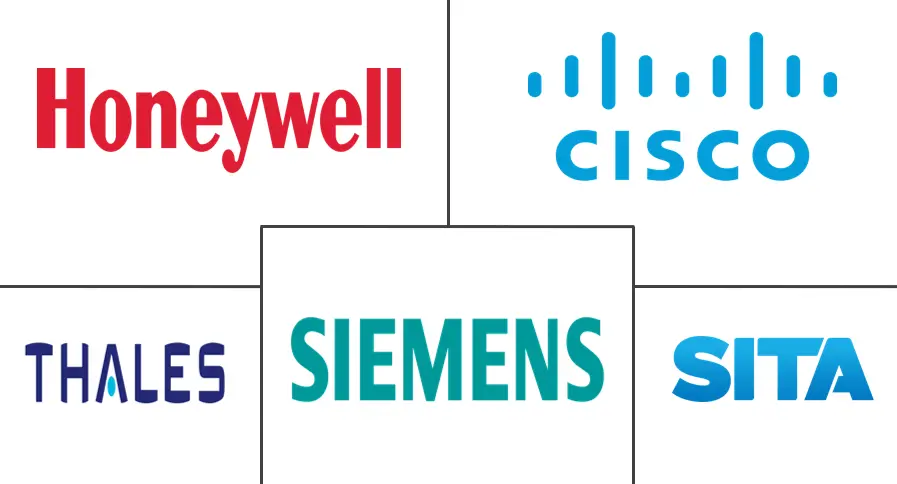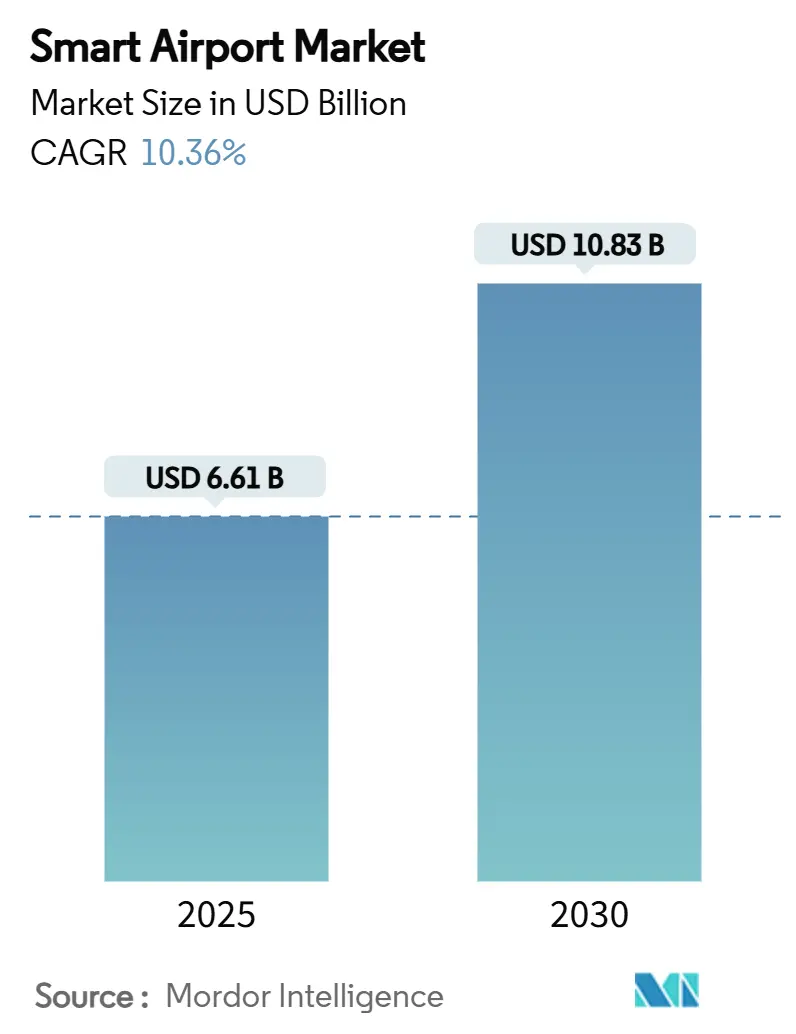
Smart Airport Market Analysis by Mordor Intelligence
The smart airport market reached USD 6.61 billion in 2025 and is forecasted to reach USD 10.83 billion by 2030, advancing at a 10.36% CAGR. Growing passenger traffic, tighter security mandates, and the need for real-time operational visibility prompt airports to accelerate digital transformation. Biometric identity management, IoT-enabled asset tracking, and AI-driven analytics are core investment themes, helping operators raise throughput without costly physical expansion. Cyber-resilience has moved to the forefront as the aviation sector recorded a 74% jump in attacks since 2020, driving parallel growth in cybersecurity budgets. Large-scale roll-outs—such as Singapore Changi’s plan to automate 95% of immigration lanes by 2026 and Dubai’s biometric boarding at Al Maktoum International by 2025—underscore how smart technologies serve efficiency and passenger-experience objectives.
Key Report Takeaways
- By technology, security systems led with 28.97% revenue share in 2024; smart retail and hospitality systems are projected to expand at a 13.20% CAGR to 2030.
- By solution, hardware held 41.89% of the smart airport market share in 2024, while services are set to grow at a 12.76% CAGR through 2030.
- By application, terminal-side systems accounted for 36.52% of the smart airport market size in 2024; landside applications are advancing at an 11.20% CAGR to 2030.
- By airport size, large hubs controlled 51.24% of the smart airport market share in 2024; small airports post the highest 13.42% CAGR outlook.
- By technology generation, airport 2.0 platforms represented 42.38% of 2024 revenue, whereas airport 4.0 solutions are forecasted to climb at a 16.21% CAGR.
- By region, North America commanded 26.57% revenue in 2024; Asia-Pacific is the fastest-growing region with a 12.44% CAGR to 2030.
Global Smart Airport Market Trends and Insights
Drivers Impact Analysis
| Driver | (~) % Impact on CAGR Forecast | Geographic Relevance | Impact Timeline |
|---|---|---|---|
| Rising passenger volumes accelerating demand for biometric screening and self-service technologies | +2.1% | Global; pioneer sites in Asia-Pacific and Middle East | Medium term (2–4 years) |
| Growing airport IT investments to support digital-first operational models | +1.8% | North America and Europe, expanding to APAC | Short term (≤ 2 years) |
| Mandatory compliance with upgraded security and border-control regulations | +1.5% | Global; strictest in advanced markets | Long term (≥ 4 years) |
| Proliferation of IoT and 5G enabling real-time visibility into airport operations | +1.7% | APAC core; spill-over to North America and Europe | Medium term (2–4 years) |
| Data-driven retail analytics improving non-aeronautical revenue generation | +1.3% | Global, with premium focus in high-traffic hubs | Short term (≤ 2 years) |
| Deployment of digital twins for predictive planning and maintenance optimization | +0.9% | Large airports globally, gradual adoption in medium airports | Long term (≥ 4 years) |
| Source: Mordor Intelligence | |||
Rising passenger volumes boosting biometric and self-service rollouts
Pandemic recovery pushed passenger queues beyond pre-2020 levels, forcing airports to add biometrics that cut document checks by 40% while sustaining security standards. The TSA now runs credential authentication units across 25 major US hubs, and Changi targets 95% automated immigration by 2026. Europe’s new Entry/Exit System, which starts in 2025, will require biometric capture for all non-EU travelers, turning regulation into a global catalyst. Although privacy concerns and system-to-system interoperability remain unresolved, the cost-benefit case strengthens as passenger volumes climb.
Growing airport IT spending pivoting to digital-first operations
Airports are re-architecting technology stacks to deliver predictive, real-time decision support. Amadeus reports that 94% of operators increased IT budgets for 2025, with digital customer experience and operational resilience as top priorities.[1]Amadeus, “2025 Airport IT Trends Survey,” amadeus.com Shenzhen Airport’s tie-up with Huawei shows the upside: 30 smart projects, including AI stand-allocation, reduced aircraft assignment time from 4 hours to 1 minute. Cloud passenger platforms extend services beyond fixed counters, yet successful roll-outs demand heavy change-management investment.
Mandatory security and border-control upgrades
Regulators are tightening cyber and physical security rules. The FAA’s proposed cyber directives respond to a 74% jump in aviation attacks, requiring holistic risk assessments from every vendor in the value chain. The TSA’s Real ID deadline in May 2025 pushes airports toward secure digital identity infrastructure. Harmonized biometric standards under ICAO frameworks encourage global interoperability but raise compliance costs, especially for smaller airports with limited budgets.
Proliferation of IoT and 5G for real-time operational data
Private 5G networks allow one million devices per square kilometer, dwarfing Wi-Fi capacity and unlocking dense IoT deployments. Ericsson lists key cases—camera surveillance, baggage handling, and mission-critical communications—where sub-10 millisecond latency improves safety and efficiency.[2]Ericsson, “Private 5G for Aviation,” ericsson.com Munich Airport’s startup accelerator already trials digital twins that visualize live operations, signaling the next step toward predictive resource planning. Capital outlays and cyber-hardening, though, still slow full-fledged adoption.
Restraints Impact Analysis
| Restraint | (~) % Impact on CAGR Forecast | Geographic Relevance | Impact Timeline |
|---|---|---|---|
| Significant capital investment and complex system integration requirements | -2.3% | Global; toughest for small facilities | Short term (≤ 2 years) |
| Growing concerns over cybersecurity and passenger data protection | -1.9% | Global; strictest in Europe and North America | Medium term (2–4 years) |
| Limited availability of skilled professionals for OT-IT system convergence | -1.2% | Global, with acute shortages in developing markets | Long term (≥ 4 years) |
| Incompatibility with legacy aviation communication systems | -0.8% | Global, with higher impact on older airports | Medium term (2-4 years) |
| Source: Mordor Intelligence | |||
High capital burden and complex integration
Integrating biometrics, IoT, and AI with legacy systems often exceeds budgets. A University of Žilina study on Central-European airports highlights financing gaps and limited tech staff that stall projects. Vendors such as Aerosimple price SaaS suites between USD 6,000 and USD 50,000 annually, reducing barriers yet not eliminating middleware complexity.
Escalating cybersecurity and data-privacy risk
Eurocontrol logged a 131% spike in aviation cyber incidents from 2022 to 2023. Delta lost USD 550 million during the 2024 CrowdStrike outage, underscoring supply-chain vulnerabilities. SITA now embeds Palo Alto AI threat analytics within airport platforms to deliver continuous monitoring. GDPR and similar laws force airports to adopt zero-trust models when handling growing biometric repositories.
Segment Analysis
By Technology: Security systems anchor adoption
Security systems commanded 28.97% revenue in 2024, underlining how mandated screening drives early digital spend. Frankfurt Airport’s AI scanners, installed in 2025, cut wait times while lifting detection accuracy. The smart airport market size for security platforms is projected to grow steadily as new regulations add biometric and cyber layers. Communication systems follow, powered by 5G backbone upgrades that support real-time situational awareness.
Smart retail and hospitality platforms, growing at a 13.20% CAGR, capture airports’ push for non-aeronautical revenue. Hong Kong International’s checkout-free “Travelwell” store showcases how data-rich shopping elevates spend per passenger. As analytics personalize offers, customer dwell time converts into margin, making retail tech the fastest-moving line in the smart airport market.
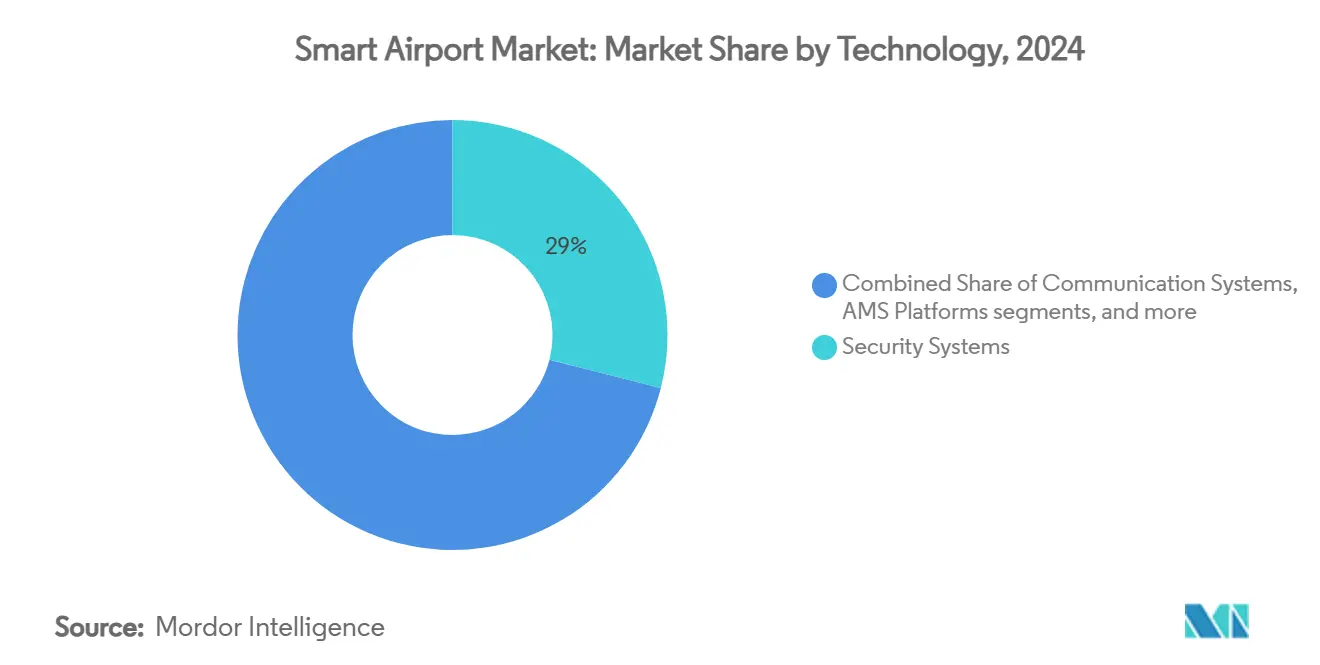
Note: Segment shares of all individual segments available upon report purchase
By Solution: Hardware remains the bedrock
Physical assets—biometric kiosks, sensors, networking gear—held 41.89% of 2024 revenue. Higher-level software cannot function without this hardware layer, which explains sustained capital flows into scanners and edge devices. Cisco notes that 72% of IT leaders now look for cross-domain platform architectures, reinforcing hardware’s foundational role.[3]Cisco Systems, “2025 Global Networking Trends Report,” cisco.com
Services, expanding at 12.76% CAGR, address skills shortages. Heathrow’s five-year extension with SITA for network stewardship signals airports’ preference to outsource lifecycle management. Cloud-delivered managed services let smaller facilities access best-in-class capabilities without building large IT teams.
By Application: Terminal side dominates, landside accelerates
Terminal areas accounted for 36.52% of 2024 revenue, reflecting dense passenger touchpoints from check-in to retail. Berlin Brandenburg’s BER Biometrics integrates every journey phase in one digital identity corridor. The smart airport market size for terminal solutions will keep expanding as AI-based crowd analytics fine-tune staffing and queue management.
Landside platforms are climbing at an 11.20% CAGR. Smart parking robots, traffic-flow dashboards, and ride-hail integrations extend seamless travel beyond the building shell. Delhi Airport’s new AI airside management suite also trims turnaround times, confirming that digital value reaches deep into ground operations.
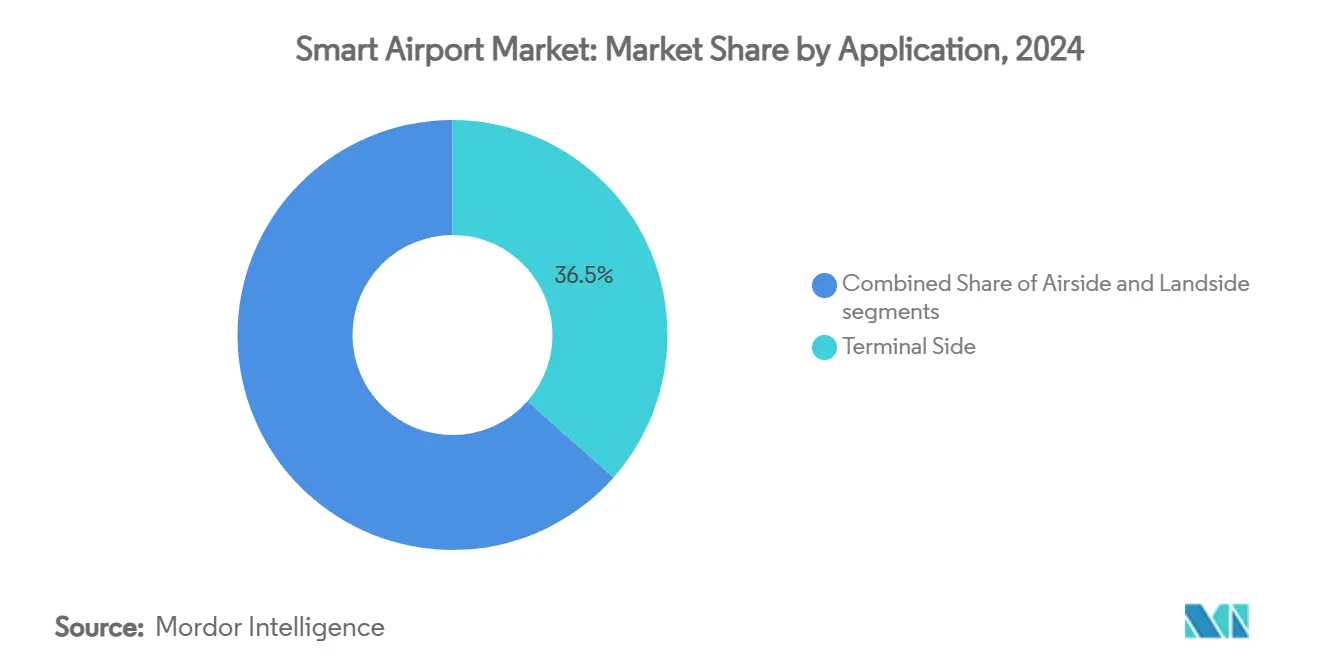
Note: Segment shares of all individual segments available upon report purchase
By Airport Size: Large hubs lead, small airports sprint
Large facilities generated 51.24% revenue in 2024 thanks to scale economics and high passenger demand. Changi Terminal 5's USD 10 billion expansion relies on biometrics, IoT, and digital twins to boost capacity to 140 million travelers. This tier's smart airport market size will grow steadily as mega-hubs showcase end-to-end use cases.
Small airports, however, post a 13.42% CAGR thanks to modular SaaS deployments. Des Moines and Waco use Aerosimple to gain dashboards once affordable only to majors. Cloud cost curves and standardized APIs help regional facilities leapfrog outdated processes, accelerating democratization inside the smart airport market.
By Airport Technology Generation: 2.0 is mainstream, 4.0 is the future
Airport 2.0 platforms represent 42.38% of current installations, encompassing self-service kiosks, automated baggage, and first-wave analytics. Miami International’s multi-year program illustrates a holistic Airport 2.0 blueprint that still delivers strong ROI.
Airport 4.0 systems, advancing at 16.21% CAGR, bundle AI, machine learning, digital twins, and autonomous vehicles into a self-optimizing environment. Nokia’s private-wireless backbone provides the connectivity scaffold, letting machine agents exchange data in real time. Adoption will remain confined to well-financed operators until costs fall and open standards mature.
Geography Analysis
North America controlled 26.57% of 2024 revenue, supported by TSA biometric deployments and the FAA’s NextGen airspace overhaul. A construction wave slated through 2025 further modernizes terminals and expands smart infrastructure. The region’s deep vendor ecosystem and stable funding pipeline sustain steady growth inside the smart airport market.
Asia-Pacific is the fastest-growing region with a 12.44% CAGR. Governments have earmarked USD 240 billion for airport builds and upgrades through 2035 to accommodate surging demand. Projects from Singapore to Vietnam and the Philippines adopt end-to-end digital designs from day one, embedding biometrics, private 5G, and digital-twin frameworks. India’s DigiYatra roll-out highlights policy-driven biometric adoption.[4]SITA, “DigiYatra Biometric Programme Overview,” sita.aero APAC's smart airport market size will overtake North America before 2030 if current funding stays on track.
Europe maintains a material share by aligning sustainability goals with technology adoption. Net-zero roadmaps push energy-efficient systems and robotic parking expansions such as Lyon’s 2,000-unit rollout. Standardized EU privacy rules shape biometric deployments, ensuring passenger trust. The region’s collaborative R&D projects—from Collins Aerospace’s high-voltage distribution for hybrid-electric aircraft to Munich Airport’s innovation hub—enrich a mature yet progressive smart airport market landscape.
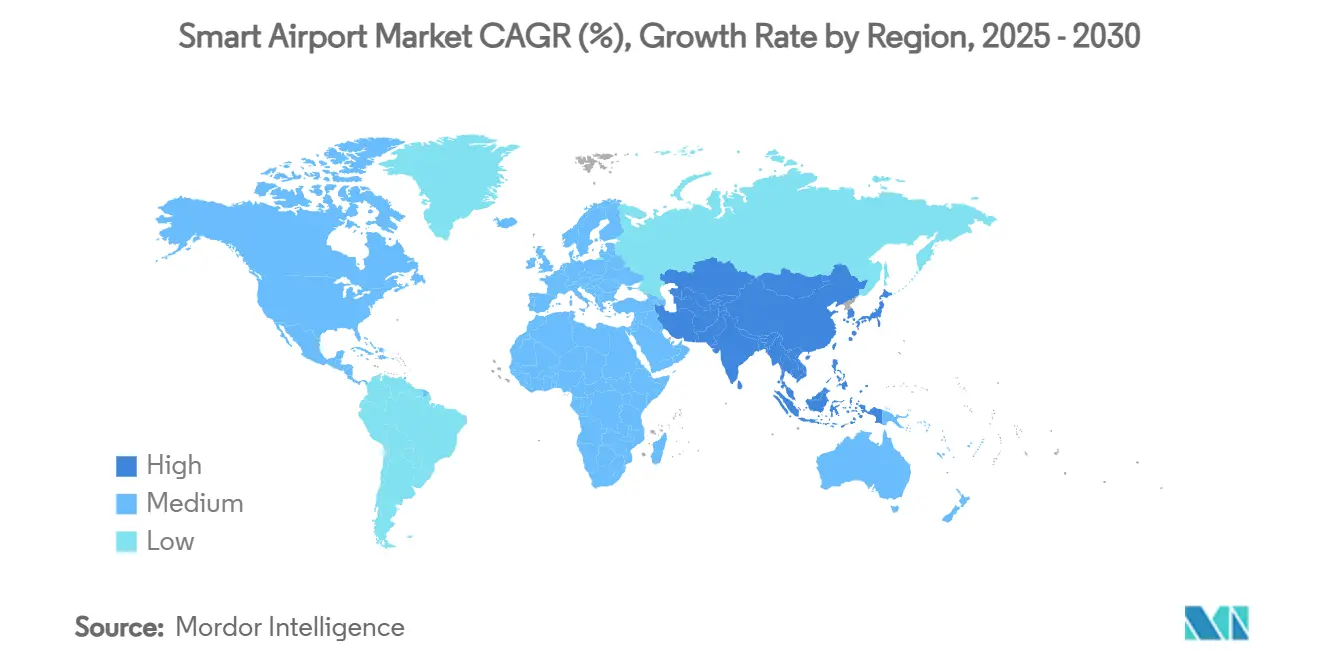
Competitive Landscape
The smart airport market is expected to be semi-consolidated. Honeywell International Inc., Cisco Systems, Inc., Siemens AG, Thales Group, and SITA N.V. headline multi-layer portfolios, while niche firms deliver AI analytics or autonomous vehicles. Honeywell’s USD 4.95 billion buyout of Carrier’s Global Access Solutions added LenelS2 and Onity, broadening its building-automation suite for airports.
Strategic alliances shape competition. SITA teamed with Palo Alto Networks for AI cybersecurity and IDEMIA for biometric identity, expanding its stack without lengthy in-house R&D. Honeywell and NXP co-develop AI-enabled flight-deck processors that feed real-time analytics into cockpit and ground systems.
Start-ups exploit gaps in passenger-flow analytics, retail personalisation, and digital twins. Yet established players still command over 60% of core security, networking, and operations software revenue, indicating moderate concentration. Airports prefer suppliers that can shoulder full lifecycle risk, nudging consolidation as point-solution vendors seek scale through mergers or partnerships in the smart airport market.
Smart Airport Industry Leaders
-
Honeywell International Inc.
-
Cisco Systems, Inc.
-
Siemens AG
-
Thales Group
-
SITA N.V.
- *Disclaimer: Major Players sorted in no particular order
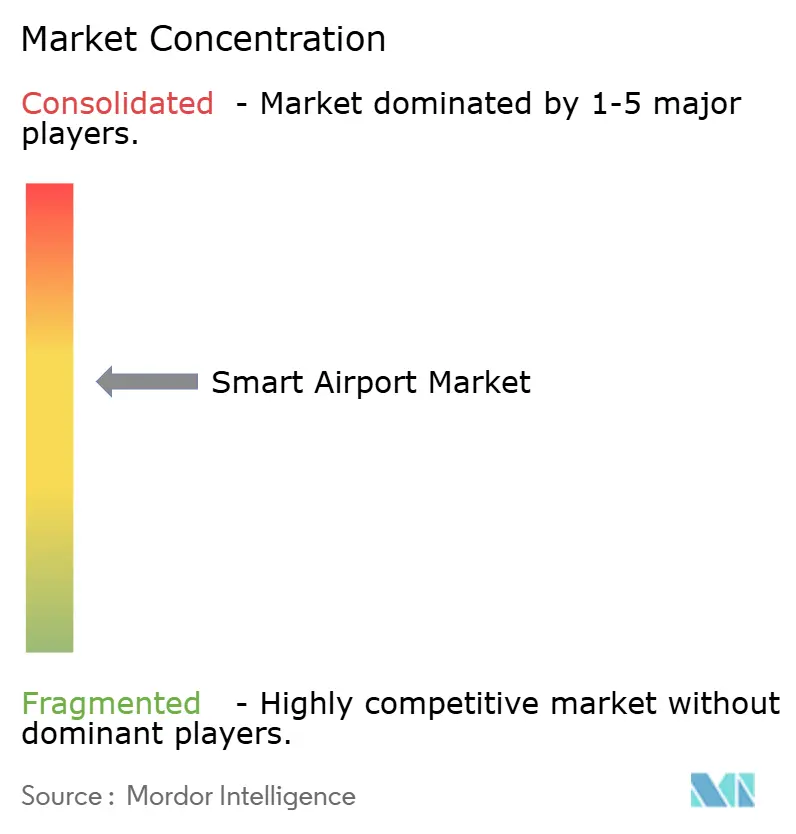
Recent Industry Developments
- June 2025: Airbus Defence and Space signed a Memorandum of Understanding (MoU) with Cluster 2 to implement smart airport digital solutions in Saudi Arabia. The agreement includes the Agnet Turnaround platform for real-time operational coordination, aiming to enhance efficiency and performance across 22 airports in the country.
- March 2025: The UK Department for Transport (DfT) allocated GBP 450,000 (USD 618,735) to six British technology companies to develop smart airport screening equipment. The investment, welcomed by airlines and airports, aims to improve threat detection, reduce false alarms, and streamline passenger screening processes.
- December 2024: In Saudi Arabia, SITA and Red Sea International Airport (RSI) established a strategic partnership to deliver smart airport systems for the Main Terminal Building. The agreement expands SITA's existing Air Taxi Terminal work, implementing integrated solutions for passenger processing, baggage handling, and automated check-in through mobile-enabled SITA Flex and Maestro systems.
Research Methodology Framework and Report Scope
Market Definitions and Key Coverage
Our study defines the smart airport market as the value of integrated hardware, software, and connected services that enable digital passenger processing, automated ground handling, data-driven airside operations, and intelligent landside facilities within commercial airports worldwide. Solutions range from biometric check-ins and IoT baggage tags to cloud-based air/ground traffic control decision platforms.
Scope Exclusions: stand-alone flight booking websites, non-integrated terminal advertising screens, and defense-only air-base systems remain outside our remit.
Segmentation Overview
- By Technology
- Security Systems
- Communication Systems
- Air and Ground Traffic Control
- Passenger, Cargo, Baggage, and Ground Handling
- Smart Retail and Hospitality Systems
- Smart Transport and Parking
- Airport Management Software (AMS) Platforms
- By Solution
- Hardware
- Software
- Services
- By Application
- Landside
- Airside
- Terminal Side
- By Airport Size
- Large
- Medium
- Small
- By Airport Technology
- Airport 2.0
- Airport 3.0
- Airport 4.0
- By Geography
- North America
- United States
- Canada
- Mexico
- Europe
- United Kingdom
- Germany
- France
- Italy
- Spain
- Rest of Europe
- Asia-Pacific
- China
- India
- Japan
- South Korea
- Rest of Asia-Pacific
- South America
- Brazil
- Rest of South America
- Middle East and Africa
- Middle East
- Saudi Arabia
- United Arab Emirates
- Qatar
- Rest of Middle East
- Africa
- South Africa
- Nigeria
- Rest of Africa
- Middle East
- North America
Detailed Research Methodology and Data Validation
Primary Research
To verify assumptions, our team interviewed airport CIOs in North America, Europe, and Asia-Pacific, tier-one system integrators, and ground-service unions. The conversations clarified real upgrade cycles, average smart-gate pricing, and regulatory bottlenecks, anchoring the secondary findings before numbers were locked.
Desk Research
Mordor analysts first built a factual spine with open datasets from bodies such as the International Civil Aviation Organization, Airport Council International, Eurocontrol, U.S. FAA Form 127, and UN Comtrade, which reveal passenger flows, flight movements, and import values for airport IT equipment. We then checked regional investment plans released by airport operators and ministries of transport, and reviewed peer-reviewed journals on aviation IoT security to gauge technology adoption curves. Subscription resources, including D&B Hoovers for company revenues and Dow Jones Factiva for contract announcements, gave spending clues that public filings miss. These sources, together with trade-association white papers and patent counts from Questel, shaped the baseline; many other references supported point validations and are not exhaustively listed here.
Market-Sizing & Forecasting
We reconstructed 2025 demand with a top-down build that starts from scheduled passenger numbers, average spend per traveler on smart-airport systems, and capex-to-opex splits, which are then cross-checked through selective bottom-up roll-ups of supplier revenues and airport project trackers. Key variables like passenger traffic growth, self-service kiosk penetration, mandated biometric gates per terminal, typical system life, and regional construction pipelines feed a multivariate regression that extends the view to 2030. Bottom-up gaps, such as undeclared retrofit budgets in smaller hubs, are bridged with analog airport benchmarks agreed in expert calls.
Data Validation & Update Cycle
Outputs pass three variance screens, colleague peer review, and a senior analyst sign-off. We refresh models each year and reopen them sooner if major stimuli, such as new IATA mandates, large stimulus bills, or disruptive cyber incidents, shift the demand curve. Every delivery therefore reflects the latest verified evidence.
Why Our Smart Airport Baseline Commands Reliability
Published figures vary because firms choose dissimilar scopes, base years, and traffic scenarios.
By aligning variables with real procurement patterns and updating them annually, Mordor Intelligence delivers a balanced, transparent baseline that decision-makers can retrace and reproduce with confidence.
Benchmark comparison
| Market Size | Anonymized source | Primary gap driver |
|---|---|---|
| USD 6.61 B (2025) | Mordor Intelligence | - |
| USD 9.53 B (2025) | Global Consultancy A | Includes broader airport ICT and ticketing platforms; limited primary validation of airport-specific spend |
| USD 8.40 B (2024) | Industry Journal B | Applies pre-COVID traffic multipliers without adjusting for staggered regional recovery |
| USD 3.51 B (2025) | Business Publisher C | Counts hardware only and assumes flat software subscription uptake |
Key Questions Answered in the Report
What is the current size of the smart airport market?
The smart airport market reached USD 6.61 billion in 2025 and is forecasted to reach USD 10.83 billion by 2030, advancing at a 10.36% CAGR.
Which region is growing fastest in the smart airport market?
Asia-Pacific shows the highest momentum, expanding at a 12.44% CAGR through 2030 thanks to USD 240 billion in planned infrastructure investments.
Which technology segment leads revenue today?
Security systems hold the top position with 28.97% revenue share because airports must comply with increasingly strict screening rules.
Which is the fastest growing region in smart airport market?
Asia-Pacific is witnessing a rapid ascent, boasting a 12.44% CAGR. If the current funding trajectory continues, the regional smart airport market will eclipse North America's size before 2030.
Why are services the fastest-growing solution segment?
Many airports lack in-house expertise and prefer outsourced integration and cyber-protection, pushing services to a 12.76% CAGR.
How does Airport 4.0 differ from Airport 2.0?
Airport 2.0 covers self-service kiosks and basic analytics, while Airport 4.0 layers AI, digital twins, and autonomous systems for self-optimizing operations, growing at 16.21% CAGR.
What are the main barriers to smart airport deployment?
High capital expenditure, complex integration with legacy systems, and escalating cybersecurity requirements remain the primary obstacles.
Page last updated on:
